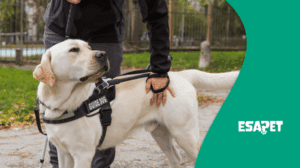How to Get a Rottweiller Service Dog: All You Need to Know

Service dogs provide essential support for individuals with disabilities. They help with mobility tasks, retrieving objects, and emotional support. While many breeds can be trained for service work, Rottweilers excel. This is due to their intelligence, loyalty, and protective nature.
Their strong work ethic and ability to learn commands make them great service and therapy dogs. Many people assume Rottweilers are aggressive or too intimidating for service work. This is a common misconception.
A Rottweiler service dog is affectionate, dependable, and highly trainable. With the right training, they can perform mobility assistance tasks. These include retrieving dropped items and opening doors.
Rottweilers also make excellent psychiatric service dogs (PSDs). They can be trained to interrupt self-harming behaviors and provide deep-pressure therapy. If properly trained, they become loyal companions who assist their handlers.
This guide will cover everything you need to know about getting a Rottweiler service dog and a prescription for it, also known as a PSD Letter. You’ll learn about training requirements, certification, and daily care to help you decide if this breed is the right fit for you.
Are Rottweilers Good Service Dogs?
Yes. With proper training, Rottweilers can be great service dogs. A Rottweiler service dog can excel in various roles. They can perform mobility assistance tasks and provide psychiatric support. They can also be medical alert dogs.
Rottweilers are highly intelligent and eager to learn. They can learn complex service dog tasks. However, training a Rottweiler service dog can be challenging.
It often requires an experienced handler or professional service dog training. This helps ensure they remain obedient and well-mannered in public settings.
Service Roles Suitable for Rottweilers
Rottweilers are strong, smart, and easy to train, making them great for many service roles. They are loyal and responsive, helping people with both physical and emotional needs. Here are some ways they can assist:
Challenges in Using Rottweilers as Service Dogs
While Rottweilers can excel as service dogs, training them for service work can be challenging. This is due to their strong-willed nature and protective instincts. Rottweilers are intelligent and independent thinkers. These traits are considered good for service dog roles.
They can also make Rottweiler service dog training difficult. These traits can sometimes translate into stubbornness. Therefore, Rottweilers need consistent training with clear commands and expectations. Structured routines are essential to reinforce obedience.
Rottweilers also have strong protective instincts. This trait makes Rottweilers suitable for handlers needing a service dog. However, this instinct can also become a hurdle in service dog work if the dog is overly wary of strangers.
Early and ongoing socialization is also crucial for a Rottweiler service dog. It helps them remain calm and well-mannered in different public environments. Training should also focus on distinguishing between real threats and normal social interactions.
Handlers can also work with a professional service dog trainer or training program.
Understanding Rottweiler Temperament and Characteristics
When it comes to service work, Rottweilers might not be the first choice. However, they have certain traits that make them suitable for various service tasks. Rottweilers are great companions. They are known for their loyalty, intelligence, and protectiveness.
They have a strong muscular build. These characteristics make Rottweilers suitable for providing emotional support and deep-pressure therapy. They can also perform mobility assistance service tasks and provide medical alert services.
Rottweilers also make for great guard dogs and police dogs. However, proper training is crucial. It helps ensure a Rottweiler service dog performs its tasks effectively.
Key Temperament Traits
Rottweilers have the right temperament and skills for service work. They are loyal, intelligent, and calm, making them great companions for people with disabilities. Here’s why they excel as service dogs:
- Loyalty and Protective Instincts: Rottweilers are deeply loyal to their handlers. They stay alert and respond quickly to their owner’s needs. Their protective nature makes them reliable service dogs. As natural guard dogs, they also provide a sense of security for those who need it.
- Intelligence and Trainability: Rottweilers are smart and quick learners. They can master complex tasks. These include retrieving objects, assisting with mobility, and detecting medical emergencies. Their ability to follow commands makes them excellent service dogs.
- Calm and Confident Demeanor: With proper training, Rottweilers develop a calm personality. This is important for service animal work. They must stay focused in crowded or stressful places. Their natural confidence helps them remain calm under pressure.
Common Misconceptions About Rottweilers
Many people mistakenly classify Rottweilers as a bully breed despite their impressive capabilities. They are often considered aggressive and dangerous dogs. These issues are mainly due to irresponsible ownership and improper training and socialization.
Rottweilers are actually protective, not inherently aggressive. They are calm, obedient, and affectionate when raised and trained correctly.
Training Rottweilers for Service Work
Training a Rottweiler to become a service dog requires dedication and patience. Rottweilers possess certain traits that are highly desirable for service work. However, training them can sometimes be challenging. They need early socialization and consistent training.
Sometimes, professional guidance is also required in addition to owner training. It helps make Rottweilers reliable service animals. Proper training ensures they can effectively assist individuals with disabilities. It also helps them remain calm and well-behaved in public places.
Essential Training Steps
Training a Rottweiler to be a service dog requires patience, consistency, and the right techniques. Below are the key steps to ensure they are well-prepared for their role:
- Basic Obedience Training: Start with foundational commands like sit, stay, come, and heel. A service dog must respond quickly and reliably in any situation. Socialization with people and different environments is important. This builds confidence and prevents fear-based reactions.
- Advanced Task Training: Once the basics are mastered, move on to specialized service tasks. Rottweilers can learn to retrieve objects, assist with mobility, and open doors. Training should be repetitive and reward-based to reinforce correct behavior.
- Public Access Training: A service dog must behave calmly in public places. Rottweilers need to ignore distractions, follow commands, and remain focused on their handler. This ensures they meet Disabilities Act requirements and can accompany their owner anywhere.
Positive Reinforcement Techniques
Using positive reinforcement techniques is essential when training Rottweilers for service work. These techniques involve rewarding your dog with treats, playtime, and praise. It helps encourage desired behavior in your Rottweiler service dog.
Reward immediately after a desired behavior to strengthen the connection. Using a consistent reward system is also helpful in avoiding confusion. This will help your Rottweiler stay motivated.
How to Get a Rottweiller Service Animal
With their strength, intelligence, and loyalty, Rottweilers can make for excellent service dogs. However, they must be trained properly. You can train your Rottweiler at home. Professional training is sometimes required to make a Rottweiler a service dog.
Below is a step-by-step guide for getting a Rottweiler service dog:
Certification Process
The ADA doesn’t need owners to get certification for their service dogs. However, a PSD letter can be helpful for travel and housing accommodations. It’s crucial to be aware of fake letters and documentation.
A legitimate PSD letter contains the credentials and signature of an LMHP. A PSD letter is different from an ESA letter. An ESA letter also comes from LMHP but contains information different from a PSD letter’s.
Train the Rottweiler for Service Dog Tasks
When it comes to Rottweiler service dog training, you have multiple options. You can train it by yourself at home. Owner training helps build a deep bond with the dog.
If you find owner training difficult, you can opt for professional training. You can hire a professional trainer or enroll your dog in a training program. These programs are designed for comprehensive service dog training.
Take Our Pre-Screening Questionnaire
Once your dog is properly trained, you can get a psychiatric service dog letter. Choosing a reliable platform like ESA Pet to get your PSD letter is crucial. ESA Pet offers legitimate PSD and ESA letters and is trusted by thousands of pet and service dog owners.
You must first take an initial screening test to get your PSD letter from ESA Pet. It consists of questions about your disability and the need for a service dog.
Consult with a Licensed Mental Health Professional
Once you complete the questionnaire, ESA Pet will connect you to an LMHP. The LMHP will verify your eligibility for a PSD by assessing your disability. If approved, they will provide an official PSD letter allowing your service dog to go with you in public spaces.
Receive a PSD Prescription Letter in 24-48 Hours
If your disability qualifies for a PSD letter, the LMHP will issue approval for a PSD Letter. You will get your legitimate PSD letter within 24-48 hours of approval. The letter is issued on the LMHP’s official letterhead and contains the LMHP’s credentials and signature.
Get your Official PSD Letter Consultation from a licensed therapist.
Get PSD Letter Now
Legal Protections and Responsibilities
Under the ADA, service animals have public access rights. This law allows them to go with their handlers to all public places. The ADA prohibits businesses or management from denying access to service animals.
However, service dog owners also have certain responsibilities. The ADA requires service dogs to be well-behaved and under the control of the owner at all times. They should also be on a leash or tethered in public settings.
In some areas, Rottweilers may face restrictions due to their perceived aggression. No state directly bans Rottweilers. However, certain cities and localities may enforce breed-specific legislation.
It is important to know that breed-specific legislation doesn’t apply to service dogs. This means if your Rottweiler is properly trained to be a service dog, localities cannot deny them access.
Differences Between Rottweiler Service Dogs and ESAs
Rottweilers can be service dogs, therapy dogs, and emotional support animals. When trained to perform tasks related to a person’s disability, Rottweilers are considered service dogs. As service dogs, they get public access rights under the ADA.
If a Rottweiler provides emotional support but is not specially trained, it is considered an ESA. ESAs don’t have public access rights under the ADA. The ADA treats them as pets.
Rottweilers can also be therapy dogs. They can provide emotional support to a group of people in settings like hospitals and retirement homes.
Service Dogs vs. Emotional Support Animals
Service dogs and emotional support animals (ESAs) provide assistance. However, they serve different purposes. Understanding their roles and legal rights is important.
- Service Dogs: These dogs are trained to perform specific tasks that help individuals with disabilities. Tasks can include guiding the visually impaired, retrieving objects, or detecting medical emergencies. They are allowed in public places under the ADA.
- Emotional Support Dogs: These dogs offer comfort and emotional support. However, they do not perform specific trained tasks. They help people with anxiety, depression, or PTSD. Unlike service dogs, they do not have public access rights but are allowed in housing under the FHA.
- Legal Protections: The ADA gives service dogs full public access. This means they can go anywhere their handler goes. ESAs are protected under the FHA, which allows them in housing. Businesses are not required to allow ESAs inside.
Comparing Rottweiler Service Dogs with Other Dog Breeds
When it comes to service dogs, the most popular breeds include Poodles, German Shepherds, and Golden Retrievers. Rottweilers also make for excellent service dogs. They are recognized for their loyal nature, intelligence, and strong build.
Below is a comparison between Rottweiler service dogs and other breeds.
Rottweilers vs. Poodles
Rottweilers and Poodles are both intelligent breeds. However, they have different strengths when it comes to service work. Here’s how they compare:
- Temperament: Rottweilers are protective and loyal, staying alert to their handler’s needs. Poodles are social and adaptable, making them better suited for public interaction.
- Trainability: Both breeds are intelligent and quick learners. Rottweilers excel in task-based training for mobility and security work. Poodles respond well to obedience training and emotional support tasks.
- Physical Suitability: Rottweilers are strong and sturdy, ideal for mobility assistance. Poodles have a hypoallergenic coat, making them a good choice for handlers with allergies.
Rottweilers vs. German Shepherds
Rottweilers and German Shepherds are strong, intelligent, and highly trainable. Both breeds are commonly used in service work, law enforcement, and protection roles. However, they have key differences in temperament, adaptability, and training needs.
- Temperament: Both breeds are loyal and protective. Rottweilers are more reserved with strangers and form deep bonds with their handlers. German Shepherds are alert and highly responsive. This makes them well-suited for active working environments.
- Service Roles: Both breeds work as police and guard dogs but serve different roles. Rottweilers excel in protective work, relying on strength and deterrence. German Shepherds are more adaptable and quick to respond. This makes them better for detection tasks.
- Challenges: Both breeds need consistent training and early socialization to prevent behavioral issues. Rottweilers are strong-willed and need an experienced handler. German Shepherds are easier to train because they are more eager to follow commands.
Rottweilers vs. Golden Retrievers
Rottweilers are protective and strong-willed. This makes them ideal for guard and mobility work. Golden Retrievers are friendly and eager to please. This makes them excel in therapy and emotional support roles. Both are highly trainable, but their temperaments suit different service needs.
Here’s the difference between Rottweilers and Golden Retrievers:
- Temperament: Rottweilers are protective and naturally cautious with strangers. In contrast, Golden Retrievers are friendly, gentle, and naturally social.
- Service Roles: Golden Retrievers are usually preferred for emotional support roles. This is because of their gentle and friendly nature. Rottweilers are better suited for mobility assistance tasks. They can also be PSDs.
Physical Attributes: Rottweilers are more robust and muscular. This makes them better suited for physical assistance tasks. Golden Retrievers are slightly smaller and lighter. This makes them easier to manage in public spaces.
FAQs About Rottweiler Service and Therapy Dogs
Are Guard Dogs and Police Dogs Good Service Dogs?
No. Guard dogs, police dogs, and search and rescue dogs are trained for protection and law enforcement. Service dogs are specially trained to assist individuals with disabilities through specialized tasks. Their different training goals make them unsuitable for direct service work.
Can My Rottweiler Be a Service Dog?
Yes. If your Rottweiler undergoes specialized training to perform specific tasks, it can be a service dog. These tasks should be directly related to your disability. According to the ADA, any dog breed can be a service dog.
Why Did Police Stop Using Rottweilers?
Police forces have mostly replaced Rottweilers with German Shepherds. This is due to their higher stamina and easier trainability for law enforcement tasks. Rottweilers are still used in some roles but less frequently.
Are Rottweilers Good for PTSD?
Yes. Rottweilers can make great psychiatric service dogs for PTSD. They can provide deep-pressure therapy and emotional support to individuals with PTSD.
What Two Breeds Make a Rottweiler?
A Rottweiler is a purebred breed, not a mix of two breeds. It originates from mastiffs and ancient Roman drover dogs.
How Do You Train a Rottweiler to Be a Service Dog?
Start with early socialization and basic obedience training. Then, proceed to advanced task training. Public access training is also crucial. You can also get help from a professional trainer to train your Rottweiler.
Can Rottweilers Be Therapy Dogs?
Yes. Rottweilers can be therapy dogs. They can provide emotional support to people in settings like hospitals.
What Legal Rights Do Rottweiler Service Dogs Have?
A Rottweiler service dog has the same legal rights as other service dogs. They can go with their owners to all public places under the ADA.
Conclusion
Rottweilers can be excellent service dogs. They have a strong build, strength, loyalty, and a protective nature. This makes them suitable for various service tasks. They can be mobility assistance dogs, PSDs, and medical alert dogs.
A common misconception about Rottweillers is that they are naturally aggressive. However, with proper training, Rottweilers make for dependable service dogs.








